







 Français
Français
Understanding > History > Transits of Venus
TRANSITS OF VENUS IN FRONT OF THE SUN :
History of observations

The first predictions
The predictions of the Venus and Mercury transits in front of the Sun requires a good knowledge of the orbital movements of interior planets. It was possible starting from the beginning of the XVIIth century thanks to the work of Johannes Kepler (1571-1630) and to the publication in 1627 of the Rudolphines Tables named thus by Kepler in homage to its former protector, the emperor of Germany Rodolphe II of Habsbourg (1552-1612). Kepler predicts the Mercury transit of November 7, 1631 and the Venus transit of December 7, 1631 that it could not observe. It also found a period approximately of 120 years recurrence for the observation of the Venus transits. The Mercury transit of November 7, 1631 was observed in Paris by the astronomer Pierre Gassendi (1592-1655) "Le rusé Mercure voulait passer sans être aperçu, il était entré plustôt qu'on ne s'y attendait, mais il n'a pu s'échapper sans être découvert, je l'ai trouvé et je l'ai vu; ce qui n'était arrivé à personne avant moi, le 7 novembre 1631, le matin". This passage was also observed by three other people Remus Quietanus in Rouffach (Haut-Rhin, Alsace), the father Cysatus in Innsbrusck (Tyrol) and an anonymous Jesuit in Ingolstadt (Bavaria). The Venus transit was not observed because of the inaccuracies of the tables Rudolphines, the transit was to occur in Europe in the night from the 6 to December 7, 1631, actually the end of the passage was visible from the Central Europe.

The english father Jeremiah Horrocks (1619-1641) predicted the following transit of Venus for Sunday December 4, 1639 at 3 hours of the afternoon (November 24, 1639 of the Julien calendar); this prediction was in contradiction with the 120 years period found by Kepler. It observed this passage from its village of Hoole (close to Preston) by projecting the image of the Sun on a graduated paper and thus carried out the first measurement of a Venus transit in front of the Sun. Actually, it could not observe all the phenomenon, having stopped its observation to be occupied with its religious obligations. Using this observation, Horrocks calculated the position of the node of the Venus orbit; it estimated that the apparent Venus diameter was not to be higher than the minute of arc and that the value of the solar parallax was not to exceed 14", which corresponds to a distance Sun-Earth of approximately 14700 terrestrial radii (either approximately 94 million kilometers). His Venus in sole visa, in which he describes his observation, will be published by J. Hevelius in 1662. Other parts of his work on Venus will be published by John Wallis in 1672. This transit was also observed by William Crabtree (1610 - 1644) in Manchester. William Crabtree was a friend of Horrocks. He was so amazed by the observation that he did not make any measurement...
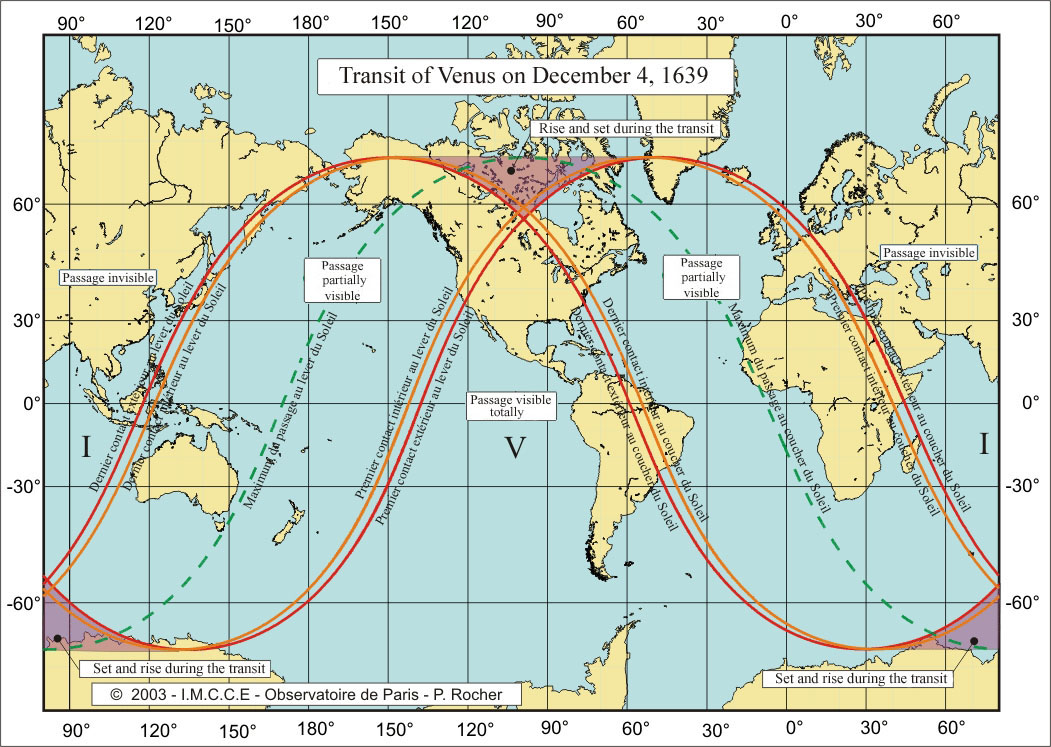
the visibily in Europe was only possible a few time before sunset, so Horrocks was lucky to have seen the event.
The determination of the parallax of the Sun
The last law of Kepler makes it possible to know the size of the solar system except for a scale factor. The knowledge of only one distance between planets or a planet and the Sun is enough to calculate all the others. The solar parallax is the angle under which one sees the radius of the Earth from the Sun, the knowledge of the parallax is thus equivalent to the knowledge of the distance Earth-Sun. The measurements and calculations carried out since the antiquity largely underestimated the actual value of this distance. The following table gives the various known values:
| Authors | Value of the distance Earth-Sun | Value of the parallax |
|---|---|---|
| Anaximandre | ~54 Earth radii | ~1.06° |
| Eudoxe | 9 times the distance Earth-Moon | - |
| Aristarque de Samos | 18 to 20 times the distance Earth-Moon
i.e. about 360 terrestrial radii |
9.549' |
| Hipparque | 2490 terrestrial radii | 1.381' |
| Posidonius | 13090 terrestrial radii | 15.757" |
| Ptolemy | 1210 terrestrial radii | 2.841' |
| Copernic | 1500 terrestrial radii | 2.292' |
| Kepler | - | smaller than 1' |
| J. D. Cassini | - | 9.5" |
| Flamsteed | - | 10" |
| Picard | - | 20" |
The last three values were calculated using measurements of the parallax of Mars at the time of its opposition of September 1672.
The transits of Venus and Mercury
In 1677, on the island of Sainte-Hélène, Edmond Halley (1656-1742) observed the Mercury transit which took place on November 7. It then imagines a method to determine the solar parallax, therefore the distance Sun-Earth. It excluded the transits of Mercury, because the Mercury parallax is too small and its passages are more difficult to observe. His method is founded on the comparison of the times of the transit of Venus measured from several sites located at different latitudes. The difference between the times of transits observed gives access to the Venus parallax, then to the parallax of the Sun. The following Venus transits occurring in 1761 and 1769, Halley left to his successors the care to carry out the observations and to apply his method. His predictions and recommendations were published in the Philosophical transactions of the Royal Society in 1691, 1694 and 1716. The method of Halley consisted in measuring the time elapsed between the first and the last interior contact of the planet Venus with the solar disc in at least two sites having the greatest possible variation in latitude. For that, one has to go often very far and one was to carry out in these sites the preliminary observations in order to determine with accuracy their geographical coordinates, the latitude to deduce from it the parallax from planet and the longitude to synchronize the observations. By this method, Halley hoped to determine the solar parallax with an accuracy of 1/500 if the observation of the contacts were made with a precision of two seconds of time. The french astronomer Joseph-Nicolas Delisle (1688-1768) proposed, since 1722, another method relating to the observation of a single phase of the passage (first or last interior contact); this method allowed to increase the list of the possible sites of observations by adding all the locations where only one phase is observable. But he asked for a very good knowledge of the longitudes of the sites of observations, that was difficult to obtain in this middle of the XVIIIth century.
Note 1:
"the Mercure crafty one wanted to pass without being seen, it had entered sooner that one did not expect it, but it could not escape without being discovered, I found it and I saw it; what had arrived to nobody before me, November 7, 1631, the morning"
The following table gives the list and characteristics passages of Mercury that occurred between the year 1720 and the year 1761.
--------------------------------------------------------------------------------- Date Instant type distance durée S46 n° S171 n° S217 n° (UT) --------------------------------------------------------------------------------- 09/11/1723 16h58h35s NC 05'46.46" 05h08m15s 45 13 55* 8 24* 22 11/11/1736 10h29h44s NC 13'58.91" 02h47m40s 43 18 64* 2 25* 22 02/05/1740 23h01h57s NC 14'41.82" 03h04m57s 50 1 54 9 26* 22 05/11/1743 10h29h46s NC 08'58.26" 04h36m24s 49 5 40 18 27* 22 06/05/1753 06h12h50s NC 02'11.49" 07h56m24s 48 6 61 4 28* 22 07/11/1756 04h10h32s NC 00'38.45" 05h30m42s 47 10 48* 12 29* 22 --------------------------------------------------------------------------------
Delisle observed the passage in 1723, but could not deduce a value of the solar parallax. In 1724 he went to London where he met Halley, he returned to France with the astronomical tables of the movements of the Sun, Moon and planets. These tables built by Halley, will be published after corrections in 1749 (seven years after the death of Halley). In 1725, Delisle left to Russia for a period of four years, he stayed in reality 22 years and returned to France in 1747 ..
The transit of Mercury in 1743 was also observed, but did not give satisfactory results, as well as reports Nicolas Louis de La Caille shortly before leaving for South Africa: " But in 1743, Heaven being very serene, ... Astronomers of the ablest who watched with great telescopes observed the contact of Mercury & the Sun which differs much between them, & the difference went to more than 40 seconds from time". It is far from two seconds precision expected by Halley.
The transit of Mercury in 1753, for which Mercury spent less than two minutes of dgree from the center of the Sun, was a repeat of the future transit of Venus. This passage relatively long, almost eight hours, would allow a more accurate measurement. In Fall 1752 Delisle planned observations from Quebec the island of Santo Domingo and Cayenne at west and India (Pondicherry, Chandernagore), Macao and Beijing to the east. Predictions were widely distributed to astronomers from all countries. Despite the observation by confirmed observers, the results were again disappointing and Le Gentil concludes in late 1753, that due the velocity of the planet, it was impossible to measure the moment of contact with an accuracy of less 2 seconds of time. Nevertheless, the observation of the transit allowed to confirm the significant differences that exist between the best planetary tables of the time. The calculation with tables of De la Hire gave a last contact 8 hours earlier than the calculation done with Halley tables! The calculation with Delisle's tables gave this same contact 17 minutes later.
On the following picture, we took a picture published by Delisle giving different possible paths based Mercury theories used, we added green, the route of passage of Mercury calculated using current theories.

These differences prompted Le Gentil to improve tables before the passage of Venus in 1761.
The transit of Venus of 1761
For this passage, the whole astronomical community was mobilized. To the difficulties due to the voyages, came to be added the seven-year war, quasi-world conflict which set ablaze not only Europe but also the seas and the colonies.
The mobilization of the astronomers for the observation of this passage was made by Delisle who sent, all over the world, his map of the visibility of the passage of 1761 to more than one hundred correspondents.
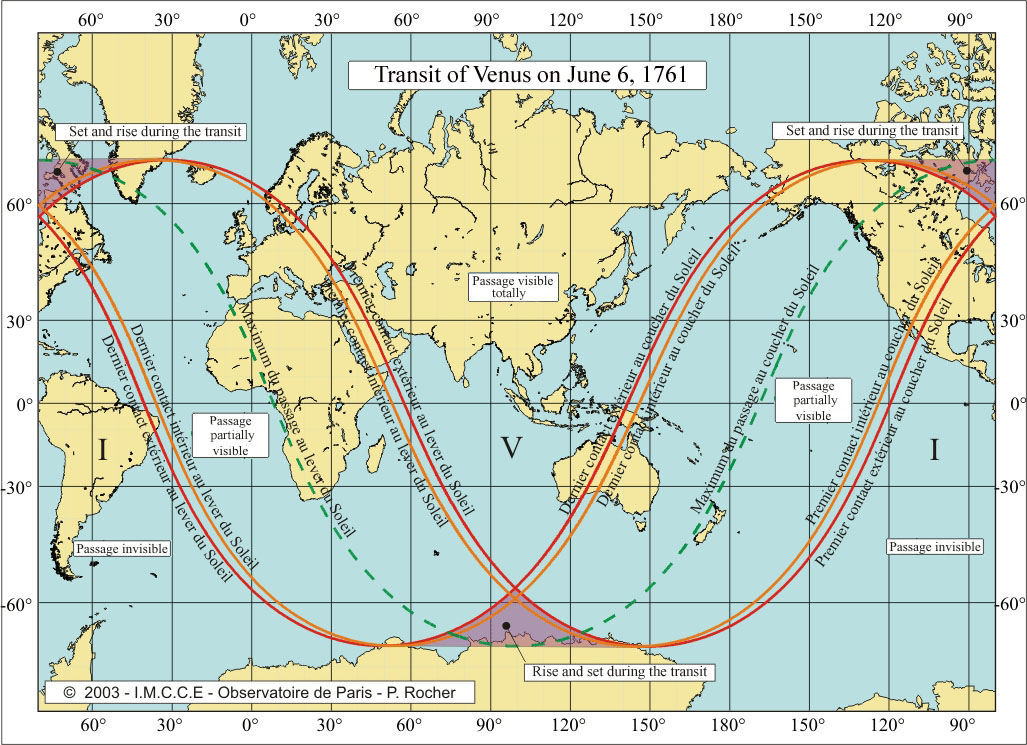
In France, the Académie Royale des sciences organized three campaigns of observations. Two of these campaigns took place in countries allied of France. César-François Cassini de Thury (1714-1784) went to Vienna and made the observation with the archiduc Joseph; Jean Chappe d'Auteroche (1728-1769) was invited to go toTobolsk in Siberia by the tzarina Elisabeth. The third campaign was the one of Alexandre Guy Pingré (1711-1796) who went to Rodrigues Island (north of Madagascar) reachable through the compagnie des Indes. A fourth astronomer, Guillaume Joseph Hyacinthe Jean-Batiste Le Gentil de La Galaisière (1725-1792), went by sea to Pondichéry in the Indies in order to observe the transit; unfortunately, his travel was interrupted: the city of Pondichéry was taken by the English! His ship went back to the île de France (nowadays Mauritius Island) where Le Gentil decided to wait the next transit eight years later. At last, the astronomer Joseph-Jérôme Lefrançois de Lalande (1732-1807) made the observation from the palais du Luxembourg in Paris.
The english astronomers organized two campaigns of observation far from England. Nevil Maskelyne (1732-1811) went to Sainte-Hélène Island where he was not able to observe the transit because of the bad weather. A second team, composed of Charles Mason (1728-1786), James Bradley (1693-1762) and Jeremiah Dixon (1733-1779) was supposed to observe from Bencoolen (Sumatra). In fact, they observed the transit near Capetown, Bencoolen having been taken by the French! John Winthrop, professor in Harvard went to Saint-John (Terre-Neuve) where "entouré de milliards d'insectes décidés à saboter sa besogne"(note 1) he succeeded to observe the last contact of the transit.
Other countries decided to participate to the campaign. The german Maximilien Hell made the observation from Vienna, the swedish Petr Wargentin at Stockholm, the danish Christian Horrebow at Copenhague, the italian Eustacio Zanotti at Bologne, the portugese De Almeida at Porto, the dutch Johan Lulofs at Leiden, Jan de Munck at Middelburg, Dirk Klinkenberg at Den Haag and, at last, Johan Maurits Mohr at Batavia (Jakarta). The total number of professional observers for this transit was 120, on 62 sites (S. Newcomb, 1890). It is interesting to note that some of the sites of observation have been selected by Halley (Bencoolen, Pondichéry, Batavia) in 1716.
The results were rather disappointing, the values found for the solar parallax varied from 8.5"to 10.5" according to the authors who made the reductions of the observations. This great margin of error is due to two principal causes, a bad knowledge of longitudes of the sites of observation and the phenomenon known as of the black drop which distorted the determination of the moments of the first and the last interior contact.
Two phenomena related to diffraction: the Mercury volcano and the black drop.
During the first observations of the Mercury transits in front of the Sun, one saw a bright point in the center of the black disc of planet. This point shining was interpreted as a volcano in eruption and as an optical illusion by others. It actually acts as a figure of diffraction whose theory can be completely carried out and the phenomenon reproduced in laboratory. This phenomenon appeared when one reduced the aperture of the instruments with a diaphragm and the phenomenon disappeared when one observed with full aperture. The phenomenon known as the black drop, which disturbed the observations of the interior contacts of the Venus transits is also observable in the case of the Mercury transits. This phenomenon is due to diffraction and can be reproduced and photographed in laboratory. "When the planet enters on the disc of the Sun, diffraction rounds the two brilliant points which are closed again behind it, and which actually are well frayed. When they are about to meet, Mercury seems attached to the solar edge by a kind of stalk, as a drop which will be detached from a narrow opening... For observing this phenomenon, it is necessary to employ an enlargement definitely higher than the solving enlargement, calculated for the free aperture of the refractor. If this aperture is 10 centimetres, for example, an enlargement of at least 150 times is necessary. Like the alleged Mercury volcano, the black drop can be easily reproduced at the laboratory and be photographed." (A. Couderc and A. Danjon, 1969). You can reproduce this phenomenon by bringing closer the inch and the index located at ten centimetres of your eyes and placed in front of an intense source of light (the sky, for example).
A phenomenon related to the refraction in the atmosphere of Venus.
The observation of the passage of 1761 allowed to suspect the existence of
an atmosphere around the Venus planet. That resulted in the appearance of a
diffuse aureole around the planet. This aureole, was observed between the external
and interior contacts. The aspect of this aureole varies according to the position
of planet between the external contact and the interior contact. If one notes
p the proportion of the Venus diameter outside the solar disc, the aureole is
often described like total in the vicinity of p= 0,5; it presents sometimes
an split aspect with variations of light intensity in the vicinity of the directions
of the poles of the planet. It also presents the aspect of a small luminous
pyramid (observation of Rittenhouse at the time of the passage of 1769). These
different aspects will be also noted at the time of the observation of the following
passages and will be explained theoretically by the presence in an atmosphere.
Note 1: "surrounded by billions of insects decided to sabotage his work"
The transit of 1769
The experience gained at the time of the observation of the passage of 1761 will be used to improve the methods of observations for the passage of 1769. Lalande organized the observations of the french astronomers. The study of the sites favourable for the observations was made by Pingré. Le Gentil remained in Madagascar, went initially to Manila, then in Pondichéry where a fatal cloud deprived it of the observation. "C'est là, le sort qui attend souvent les Astronomes. J'avois fait près de dix mille lieues; il sembloit que je m'avois parcouru un si grand espace de mers, en m'exilant de ma patrie que pour être spectateur d'un nuage fatal, qui vint se présenter devant le Soleil au moment précis de mon observation, pour m'enlever le fruit de mes peines & de mes fatigues"(note 1).. Chappe accompanied by the engineer geographer Pauly, the designer Noël and the clock maker Dubois as well as two Spanish astronomers Vicente de Doz and El Salvador de Medina went in Low California on the West coast of Mexico, close of the Cape Lucas in a Spanish mission bearing today the name of San José del Cabo. The observation of the passage by Chappe and its collaborators was a success, they stayed there to observe the eclipse of the Moon on June 18, 1769 in order to determine with precision the longitude of their site of observation.they succumbed to an epidemic of typhus which decimated the three quarters of the population. Only Pauly survived the epidemic. The third french mission was a travel by sea of which the goal was not only the observation of the Venus passage but to test the marine clocks invented by Berthoud. Pingré and the Comte de Fleurieu, sponsoring the voyage, observed the Venus transit from the Cape François in Saint-Domingue.
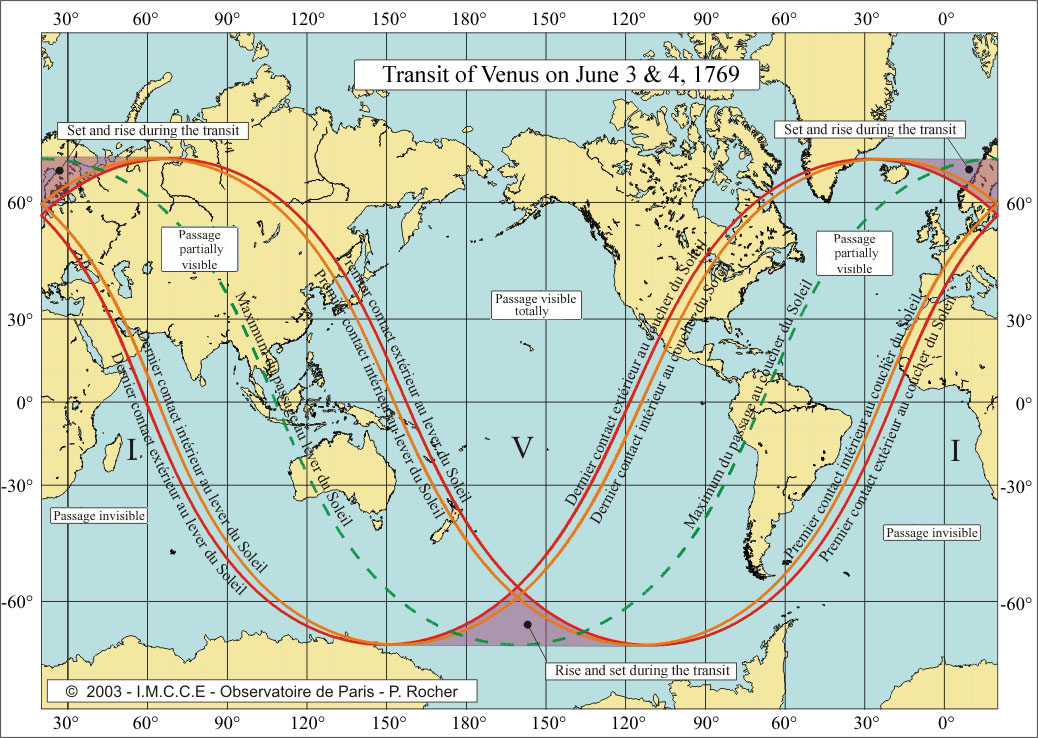
In England the observation of the passage of 1769 was actively prepared. Since 1763, James Ferguson described the future passage in the Philosophical Transactions and two years later, Thomas Hornsby published an important report on the advisability of observing the next passage. "In this uncertainty, the astronomers of the present age are peculiarly fortunate in being able so soon to have recourse to another transit of Venus in 1769, when, on account of that planet's north latitude, a difference in the total duration may conveniently be observed, greater than could possibly be obtained, or was even expected by Dr. Halley from the last transit". In November 1767, a special committee was created to prepare the observation of the passage of 1769. This committee decided to send three teams of observers. A first team of observers, composed of Dymond and Wales, went to Fort Churchill in Hudson Bay. A second team trained by the father Maximilen Hell, assisted by the Danish astronomer C. Horrebow and a young botanist Borgrewing, was to go to Vardö, a small island in the north of the Scandinavian peninsula and a last team was to go in the islands of the South Seas like had suggested it Thomas Hornsby. This last mission, was also used to explore the South Seas and was entrusted to a young unknown lieutenant, James Cook, the observation of the Venus passage having to be made in Tahiti, islands discovered two years earlier by Samuel Wallis. The observation in Tahiti was made by Charles Green and James Cook. To these three teams it is advisable to add Bayley and Dixon, Bayley observed the passage to the Cape North and Dixon observed it on the Norwegian island of Hammerfest. In addition to these observations, there were also those carried out (approximately 90) in the american british colonies under the impulse of Winthrop, author of the only american observation in 1761.
The imperial Academy of Russia under the impulse of the tzarina Catherine II also invited many foreign astronomers to come to observe the Venus passage. It was the case of the german Jesuit C. Mayer, of the swiss astronomers Mallet and Pictet and of the swedish J. Lexell, the famous mathematician Leonard Euler also made the voyage. Russia sent these observers on many sites distributed on its vast territory (Yakutsk, Orks and Orenburg in the south of the Ural, the Cola peninsula, St-Petersbourg).
Third place for the number of observations carried out at the
time of the first Venus passage, the English will pass in the first place with
69 observations on distinct sites. They were followed by France with 34 observations
only, which marks the future decline of the scientific hegemony of France in
Europe. Finally the passage of 1769 showed 151 professional observations, distributed
on 77 sites. In spite of the numerous instruments used for the observation,
(27 achromatic refractors -there were only three for the observation of the
passage of 1761-), the observations did not make it possible to provide a final
value to the solar parallax. Moreover it should be announced that this observational
campaign had made many victims in the team of Chappe in Mexico, and also during
the voyage of Cook.
The following table provides the various values allotted to the solar parallax
following these observations.
Le tableau suivant fournit les différentes valeurs attribuées à la parallaxe solaire à la suite de ces observations.
| Author(s) | Values |
|---|---|
| William Smith | 8.6045" (1770) |
| Thomas Hornsby | 8.78" (1770) |
| Pingré and Lalande | 9.2" et 8.88" (1770) |
| Pingré | 8.80 (1772) |
| Lalande | between 8.55" and 8.63" (1771) |
| Planmann | 8.43 (1772) |
| Hell | 8.70" (1773/1774) |
| Lexell | 8.68" (1771) and 8.63" (1772) |
One can conclude that the parallax lies between 8.43"and 8.80", which represents a clear improvement compared to the values obtained after the first passage which gave a parallax ranging between 8.28"and 10.60"
The reduction of the observations of the passages of 1761 and 1769 was taken
again thereafter by J.F. Encke in 1824 and S. Newcomb in 1890.
Note 1:
"It is there, the fate which often awaits the Astronomers. I travelled nearly ten thousand miles; it seemed that I traversed a so great space of seas, by exiling me of my fatherland that to be spectator of a fatal cloud, which was presented in front of the Sun at the precise moment of my observation, to remove me fruit of my sorrows & my tirednesses"
The transit of 1874
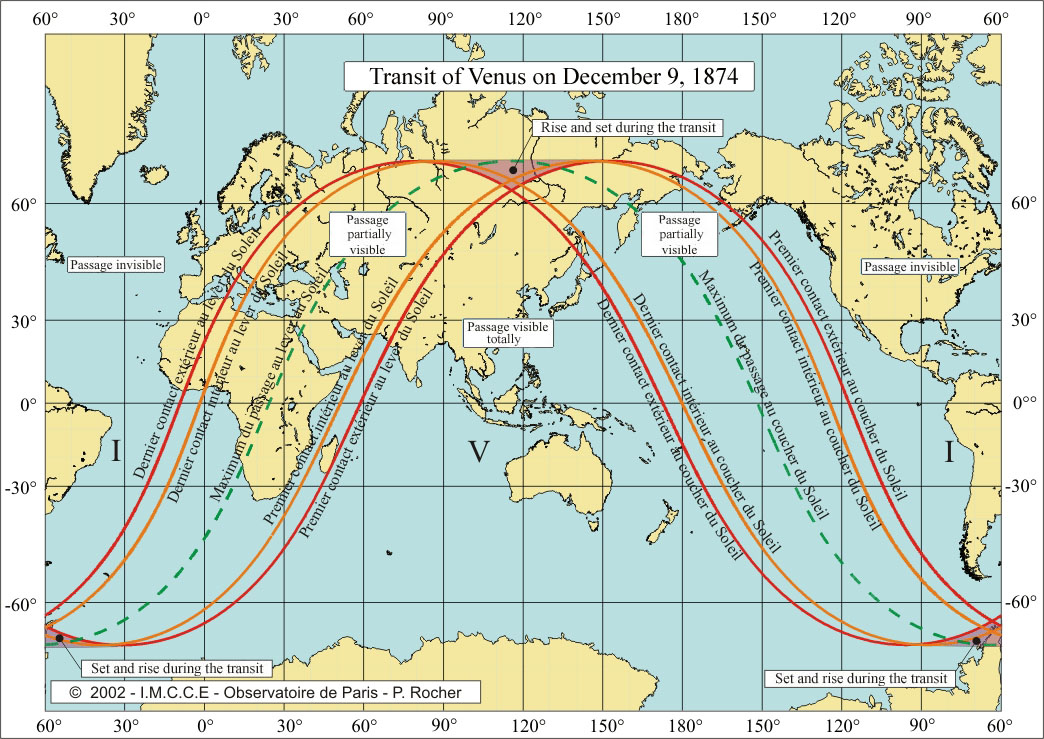
In one century, technical progress was important, in particular with the contribution of the photographic recording, the improvement of the clocks and the best knowledge of longitudes. The observation of the passage of 1874 was possible from China (Peking), Japan (Nagasaki), in the Asian North-East and in Australia.
The English under the direction of the royal astronomer Sir George Airy organized five missions distributed out of eight observation stations: one in Egypt in Alexandria, one in the Rodrigues island (become English), one in New Zealand in Christchurch, two in the Kerguelen islands at Port Christmas at the site of Bay of the Observatory and in Port Palliser and three in the islands Sandwich (currently archipelago of Hawaii) in Honolulu, Owhyhee and Atoui. To these missions it is advisable to add the private voyage of Lord Lindsay to Mauritius.
In Russia the phenomenon was visible and was observed from 24 stations distributed on a great part of the going territory from the sea of Japan to the Black Sea.
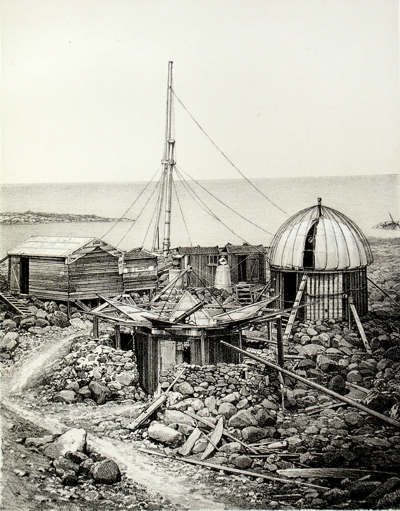
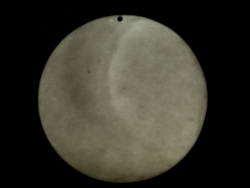
The French, organized six missions; three in the boreal hemisphere, including a mission to China in Peking directed by Fleuriais, one in Japan entrusted to the astronomers J. Janssen and F. Tisserand, one in Indo-China in Saigon directed by Héraud and, three in the southern hemisphere, of which one in the Campbell island entrusted to Bouquet of Grye, one in the Saint-Paul island entrusted to the commander Mouchez and finally one in New Caledonia at Nouméa entrusted to André. On this occasion, Janssen had invented a kind of "photographic revolver" with which it took 48 stereotypes of the Venus passage on a plate circular daguerreotype.
Note also three more expeditions, two german (one in Mauritius Island and the other in Kerguelen Islands) and an american expedition to Kerguelen Islands.
The transit of 1882
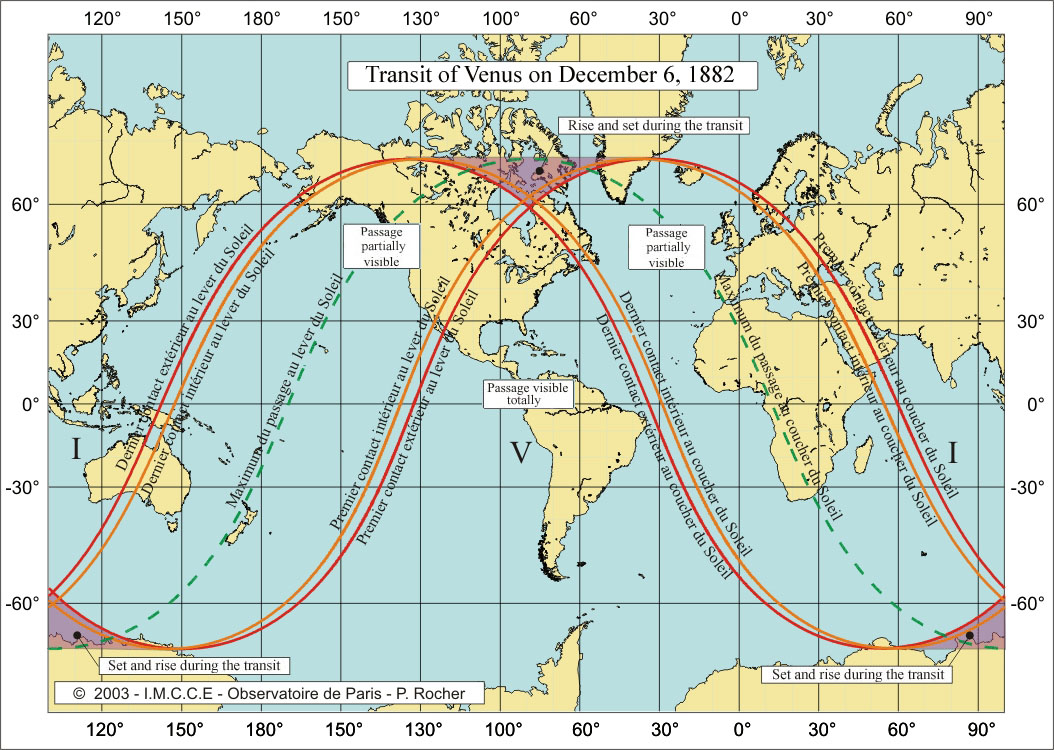
The passage of 1882 will be also the occasion of many voyages. The passage was visible from South America.
The French organized ten missions: a mission to the island of Haiti (Callandreau), one to Mexico (Bouquet of Grye), one to Martinique (Tisserand, Bigourdan, Puiseux), one to Florida (colonel Perrier), to Santa-Cruz in Patagonia (commander Fleuriais), one to Chile (lieutenant of Bernardières), one to Chubut (Hatt), one to Rio-Negro (Perrotin, the director of the observatory of Nice), one to Cape Horn (lieutenant Courcelle-Seneuil) and finally one to Bragado (lieutenant Perrin).
The naval observatory of Washington D.C. sent eight missions throughout the world to observe the passage.

These voyages, again, were not limited to the study of the Venus passage, thus in the Sandwich islands, in 1882, the German settled in Royal Bay within the framework of the first international geophysical year. A similar station was installed by the French in the Orange bay close to Cape Horn. The same day, these two stations recorded strange oscillations of the tide. They knew later than it was a shock wave caused by the explosion of the Krakatoa volcano in Indonesia!
The naval observatory of Washington D.C. sent eight missions throughout the world to observe the passage.
The reduction of the observations of these last two passages made it possible to Newcomb to calculate a value of the solar parallax with a precision of the order of the hundredth of second of degree. Other measurements of the parallax were used to determine the solar parallax: the measurements of the parallax of Mars in the vicinity of its oppositions were continued. The measurements of the parallaxes of the asteroids at the time of their passages close to the Earth were also conducted. But it will be necessary to await measurements of distance by methods radar to obtain a very good value of the solar parallax and to confirm the good value obtained by Newcomb starting from the Venus passages.
The following table gives a summary of the various determinations of the parallax of the Sun since the middle of the XVIIIth century.
| Method / author | Parallax |
|---|---|
| Transits of 1761 and 1769 | 8.43" and 8.80" |
| Transits of 1761 and 1769, Encke 1824 | 8.5776" |
| Transits of 1761 and 1769, 1835 | 8.571 +/- 0,037" |
| Parallax of Mars, Hall, 1862 | 8.841" |
| Parallax of the asteroid Flora, Galle, 1875 | 8.873" |
| Parallax of Mars, Gill, 1881 | 8.78" |
| Transits of 1874 and 1882, Newcomb, 1890 | 8.79" |
| Parallax of the asteroid Eros, Hinks, 1900 | 8.806" |
| Parallax of the asteroid Eros, 1941 | 8.790" |
| Radar measurements, NASA, 1990 | 8.79415" |
Subsequently, observations of the passages of Venus were neglected, other methods, such as direct astrometric observation of Mars, allowed to get this solar parallax. The approach of the asteroid Eros in the vicinity of the Earth allowed a precise measurement in 1941. The radar observation on Mars has since replaced the old measures.
The transits of 2004 and 2012

The former transits observable during the XVIIIth and XIXth centuries were observable far from Europe: fortunately the first transit occuring during the XXIst century (2004) was easily and completely observable from Europe. The scientific interest was very low since the parallax of the Sun was determined through the space probes on the planet Mars but a pedagogic project was set up by the European community to ask students, pupils in high schools and amateur astronomers to make the same observations than in the oild time. Fortunately, voyages were not necessary thanks to Internet, the time and the position of the observers were not a problem thanks to the GPS and the use of electronic camera, video or CCD allow to take a lot of pictures analyzed after the event.

Many observations were made as the image above. From 4500 observations, we were able to extract the information on the time of the contacts during the transit. The results obtained for the calculation of the Astronomical Unit are provided in the table below and are compared with the rsults obtained during the previuos transits. Surprisingly, the observations by amateurs or students are more accurate than the observations made by the astronomers of the former centuries. This is explained by the new technics used for observing and the use of computers for image analysis.
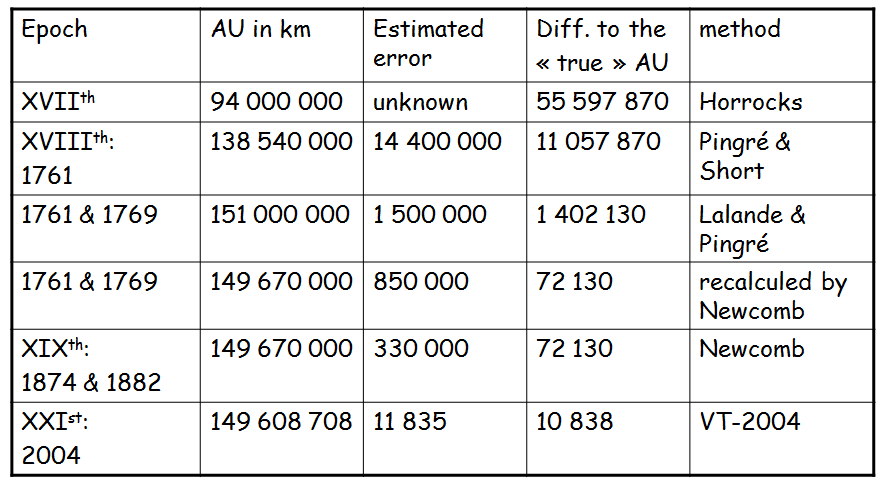
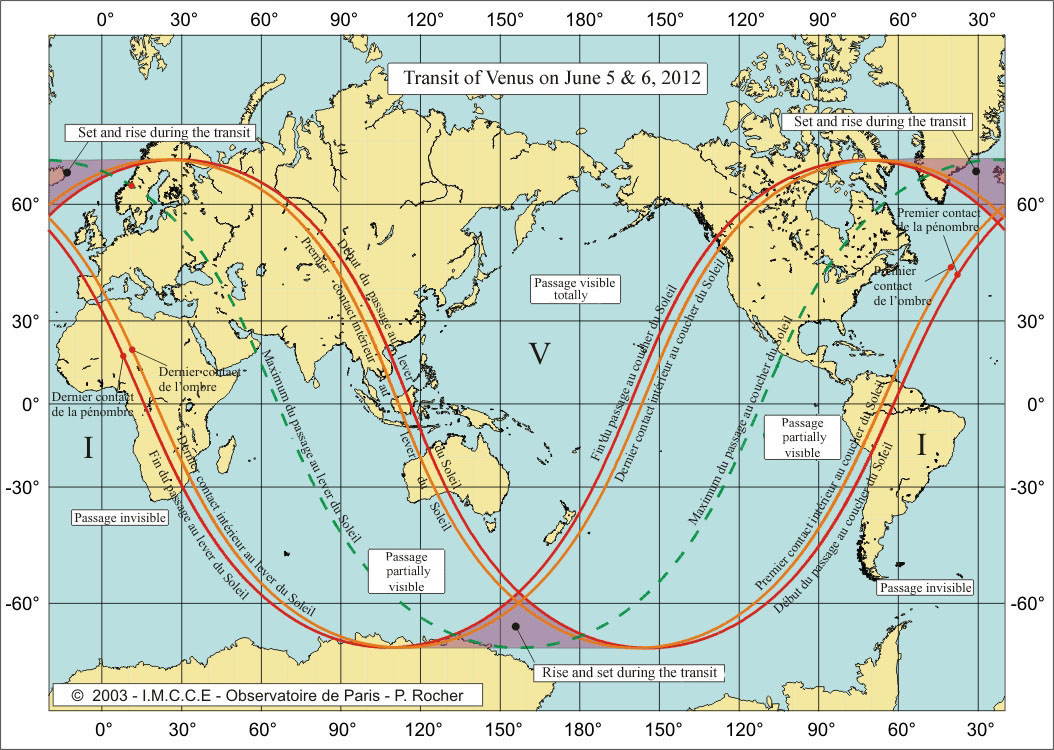
Unfortunately the transit of 2012 was not completely observable from Europe and very few observations were made. More, the weather was not so favorable in 2012 than it was in 2004 with a beautiful sunny day on June 8, 2004...
Credit: P. Rocher, J.E. Arlot IMCCE/observatoire de Paris